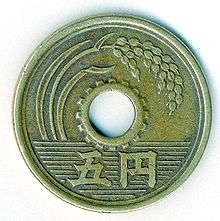1 yen note
[1] The ¥1 note is a Japanese banknote from the Bank of Japan (including the silver issue convertible bill).
Overview
The Bank of Japan produced four types of one yen bills: the old gold ¥1 issue, the remodeled ¥1 issue, the standard ¥1 issue, and the A-Series ¥1 bills. Most of the bills were issued before the war, during the war and immediately after the end of World War II (Up until 1951) have been taken out of circulation due to the abolition of the Gold standard, and Japan's system of yen switching. Though, all bills printed by the bank of Japan are still legal tender.
Old Issue Bill
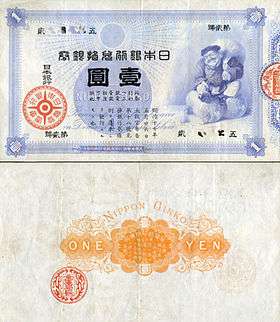
Bank of Japan Convertible Silver Issue Bills
- Face Value: One Yen (壹圓)
- Inverse: Daikokuten (大黒天)
- Reverse: Ripple Design
- Size: Vertical - 78mm, Horizontal - 135mm [1]
- First Printing: September 8, 1885 (Meiji 18)
- Final Printing: October 1, 1958 (Shōwa 33)
The Old Issue Bill was nicknamed the "Daikoku Bill" because of the picture of Daikokuten on the inverse of the bill. The designer is Edoardo Chiossone of Italy. It is valid today even more than 120 years since the bill was first issued in 1885. There is a character watermark of "Bank of Japan Currency" (reading from the right to the left with horizontal writing). The rules of conversion are written in Japanese and English (NIPPON GINKO Promises to Pay the Bearer on Demand One Yen in Silver - 此券引きかへ尓銀貨壹圓相渡可申候也). One the bill, the serial number is written using Chinese numerals, and it is the oldest among the still valid currency of Japan. Although it is written as "convertible silver certificate", it is now handled as an invalid banknote, so it can not be exchanged for silver coins. Although it is legal tender, at present, the bill is usually sold for its monetary value, and is usually traded for tens of thousands of yen, or sometimes, even more (US$95 or greater).
Remodeled Bill

Bank of Japan Convertible Silver Issue Bills
- Face Value: One Yen (壹圓)
- Inverse: Takenouchi no Sukune (武内宿禰)
- Reverse: One Yen Silver Bill (一円銀貨)
- Size: Vertical - 85mm, Horizontal - 145mm [1]
- First Printing: May 1, 1889 (Meiji 22)
- Final Printing: October 1, 1958 (Shōwa 33)

The Old Issue Bills were mixed with konjac in order to increase the strength of the banknote, due to this, many insects and rats often ate them, so "modified tickets" including this one yen note were issued to supplement against this problem. Also, black watermarks were adopted. On the bill front of the bill, the rules of conversion are written in Japanese, while the reverse side is written in English (NIPPON GINKO Promises to Pay the Bearer on Demand One Yen in Silver - 此券引きかへ尓銀貨壹圓相渡可申候也). Initially, the serial numbers were written in Chinese Numerals, in 1916, the date was became written in Arabic numerals. In 1897, when Japan shifted from a Silver standard to a Gold standard, there was initially going to be a one yen gold coin for conversion, but due to the advent of this not being created, the Remodeled Bill was used instead.
Edited Bill
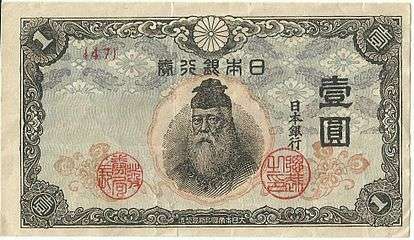
Bank of Japan Bills
- Face Value: One Yen (壹圓)
- Inverse: Takenouchi no Sukune (武内宿禰)
- Reverse: Ube shrine (宇倍神社)
- Size: Vertical - 68mm, Horizontal - 122mm [1]
- First Printing: December 15, 1943 (Shōwa 18)
- Final Printing: October 1, 1958 (Shōwa 33)

As Japan plunged deeper into World War II, banknotes became more poorly made. For example, the serial number was omitted in 1944. This bill was nicknamed the "Military Bank One Yen Bill" (中央武内1円).[2]
A-Series Bill
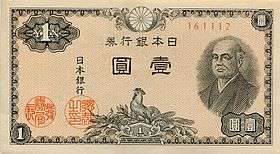
Bank of Japan Bills
- Face Value: One Yen (壹圓)
- Inverse: Ninomiya Sontoku (二宮 尊徳)
- Reverse: Ripple Design
- Size: Vertical - 68mm, Horizontal - 124mm [1]
- First Printing: March 19, 1946 (Shōwa 21)
- Final Printing: October 1, 1958 (Shōwa 33)
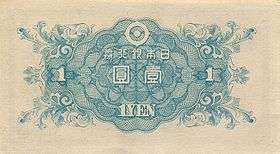
The A-Series One yen bill was designed by the private sector and printed by companies such as Dai Nippon Printing and Toppan Printing. There was no watermark featured on the A-series one yen bill.
Unissued Bill
There was a B-Series version of the one yen bill. It featured a portrait of Ninomiya Sontoku (二宮 尊徳). Due to the production of the one yen aluminum coin in 1955, there wasn't a need to circulate the bills.
Watermark
-

The old one yen bill: "Bank of Japan notes" (read from right to left)
-

Remodeled one yen bill, Government Seal of Japan and "Silver Standard One Yen Bill"
-

Edited Bills, Government Seal of Japan
See also
References
- 1 2 3 4 5 "One Yen Tickets". boj.or.jp. Bank of Japan. Retrieved November 19, 2016.
- ↑ "One yen bills". buntestu.net. Buntetsu Museum of Banknotes and Coins. Retrieved November 19, 2016.
